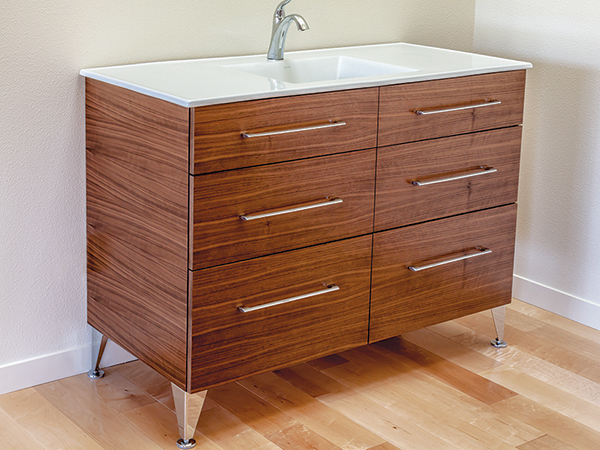
One of my brothers is in the process of remodeling his master bath. He picked up some beautiful tongue-and-groove white oak, somewhat roughsawn, for the double sink vanity top. He asked me what I thought would be a good finish for it, and at first I suggested tung oil. Then Danish oil. I then rethought it and said boiled linseed oil. Well, now I’m questioning my thoughts, which are starting to run all over. The shower is in its own “room” with the toilet, so there isn’t a lot of humidity in the air, but of course there will be some splash around the sinks from normal use. Any recommendations on the best finish? – Kevin D. Harris
Tim Inman: If you think having the shower in another room will save your vanity top from living in a high humidity environment, well… Think again. Every time that surface is used, it will be wetted. Every time that surface is cleaned, it will be wetted and soaped up with some new super-duper cleaner. A vanity top is a harsh environment for wood and for finishes. A polyurethane meant for wet duty, like a marine spar poly, would be my first choice. Actually, make that my second choice. My first choice would be soapstone, or marble, or ceramic, or porcelain, or… You get the point. Something that is nonabsorbent would be best. I’d put the wood on the wall or someplace where it will live a better life and where you will enjoy having it every day. Putting wood on a vanity top will have seemed like a great idea and give you pleasure for about the first six weeks. Then, it will be a disappointment and a continuing maintenance nightmare. These are my thoughts, of course, but I speak from a lifetime career as a furniture finisher, restorer/conservator and finish problem consultant. Remember, oak — especially white oak — is full of tannin and will just jump at the chance to turn dark purple/blue when allowed to be wet.
Chris Marshall: We woodworkers love, love, love our wood. But no matter how much I love it, I don’t think it belongs in every application. Here, I’m reminded of that old phrase, “Just because you can doesn’t mean you should.” I think it applies when it comes to wood with a finish on it that will be routinely exposed to water and cleaning chemicals. You’ve probably seen those gorgeous bathtubs or sink bowls on the Internet that are made entirely from some dark, exotic, lovely wood. They sure do look sculpturally amazing to the woodworker in me, but how long will the finish on that tub really last? How long will that sink bowl stay watertight? No matter how much we fall in love with the idea that wood is the ideal medium for all things, there are some immutable truths that cannot be denied about it. Wood moves. Wood absorbs moisture. Wood joints can leak. Finishes fail. We can make these sorts of plumbing fixtures from wood — but in terms of durability and overall good sense about the material at hand, should we?
I have no doubt that a white oak vanity top will last a long time, but that doesn’t mean the finish on it will hold up. No matter what topcoat you choose, water is absolutely going to find its way into the nooks and crannies of tongue-and-groove joints laid horizontally. Then, once the wood gets damp and probably stays damp, moisture will compromise the adhesion of the finish on top. It will fail, and the evidence will be obvious. I’m not sure there’s a “perfect” finish out there that won’t require routine maintenance. So, my advice? Save the white oak for use as wainscot. Or have your brother consider building the vanity’s base from it instead of the top. Then I’d go for a more waterproof, maintenance-free material for the countertop. There are lots of beautiful options these days that would make a white oak base look absolutely fantastic. And the whole project will last. In the end, isn’t that the most important thing?





